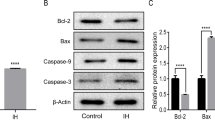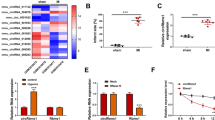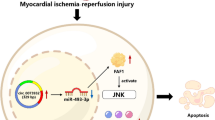Abstract
Objective
Myocardial infarction (MI) is a major cause of cardiovascular disease which poses great healthy and financial burden for individuals. MI can be mainly induced by hypoxia. Therefore, in this study, we aimed to explore the function and mechanism of lncRNA H19 on hypoxia-induced pyroptosis of cardiomyocytes.
Method
Peripheral blood from healthy controls and MI patients was collected for determination of mRNA and protein expression levels of H19 and CYP1B1. The correlation between these two factors was analyzed. Then MI rat model was established and injected with H19 overexpression/CYP1B1 knockdown plasmid, in which the infraction area and pathological morphology were observed. Hypoxic cardiomyocytes were transfected with overexpression or knockdown of H19 and CYP1B1 for determination of NLRP3, ASC, caspase-1, IL-1β, IL-18, CyclinD1, and PCNA. Cell proliferation ability was assessed by CCK8. RIP and dual luciferase gene reporter assay were applied to verify the binding among H19, PBX3 and CYP1B1.
Results
Downregulated H19 and upregulated CYP1B1 were observed in MI patients. A negative correlation was found for H19 and CYP1B1 expressions. Transfection of H19 overexpression or CYP1B1 knockdown could attenuate the MI progression in MI rats. In hypoxic cardiomyocytes, H19 overexpression or CYP1B1 knockdown could also inhibit NLRP3, ASC, caspase-1, IL-1β, and IL-18 in addition to suppressing cell apoptosis rate and promoting cell proliferation rate. Different expression pattern was found in cells transfected with H19 knockdown or CYP1B1 overexpression. Overexpression of CYP1B1 could abrogate the suppressive effect of H19 on pyroptosis of cardiomyocytes. H19 could inhibit activity of CYP1B1 promoters by regulating PBX3.
Conclusion
H19 could inhibit CYP1B1 expression in a PBX3-dependent way and thus attenuate cell pyroptosis of cardiomyocytes.






Similar content being viewed by others
References
Tama BA, Im S, Lee S (2020) Improving an intelligent detection system for coronary heart disease using a two-tier classifier ensemble. Biomed Res Int 2020:9816142. https://doi.org/10.1155/2020/9816142
Hausenloy DJ, Yellon DM (2013) Myocardial ischemia-reperfusion injury: a neglected therapeutic target. J Clin Invest 123(1):92–100. https://doi.org/10.1172/JCI62874
Anderson JL, Morrow DA (2017) Acute myocardial infarction. N Engl J Med 376(21):2053–2064. https://doi.org/10.1056/NEJMra1606915
Brun A, Range H, Prouvost B, Mazighi M, Kapila Y, Bouchard P, Michel JB (2020) Innovative application of nested PCR for detection of Porphyromonas gingivalis in human highly calcified atherothrombotic plaques. J Oral Microbiol 12(1):1742523. https://doi.org/10.1080/20002297.2020.1742523
Patel P, Karch J (2020) Regulation of cell death in the cardiovascular system. Int Rev Cell Mol Biol 353:153–209. https://doi.org/10.1016/bs.ircmb.2019.11.005
Lee S, Choi E, Cha MJ, Hwang KC (2015) Looking for Pyroptosis-modulating miRNAs as a therapeutic target for improving myocardium survival. Mediat Inflamm 2015:254871. https://doi.org/10.1155/2015/254871
Benjamin EJ, Muntner P, Alonso A, Bittencourt MS, Callaway CW, Carson AP, Chamberlain AM, Chang AR, Cheng S, Das SR, Delling FN, Djousse L, Elkind MSV, Ferguson JF, Fornage M, Jordan LC, Khan SS, Kissela BM, Knutson KL, Kwan TW, Lackland DT, Lewis TT, Lichtman JH, Longenecker CT, Loop MS, Lutsey PL, Martin SS, Matsushita K, Moran AE, Mussolino ME, O'Flaherty M, Pandey A, Perak AM, Rosamond WD, Roth GA, Sampson UKA, Satou GM, Schroeder EB, Shah SH, Spartano NL, Stokes A, Tirschwell DL, Tsao CW, Turakhia MP, VanWagner LB, Wilkins JT, Wong SS, Virani SS, American Heart Association Council on E, Prevention Statistics C, Stroke Statistics S (2019) Heart disease and stroke statistics-2019 update: a report from the American Heart Association. Circulation 139(10):e56–e528. https://doi.org/10.1161/CIR.0000000000000659
Ye B, Chen X, Dai S, Han J, Liang X, Lin S, Cai X, Huang Z, Huang W (2019) Emodin alleviates myocardial ischemia/reperfusion injury by inhibiting gasdermin D-mediated pyroptosis in cardiomyocytes. Drug Des Devel Ther 13:975–990. https://doi.org/10.2147/DDDT.S195412
Jorgensen I, Miao EA (2015) Pyroptotic cell death defends against intracellular pathogens. Immunol Rev 265(1):130–142. https://doi.org/10.1111/imr.12287
Shi J, Gao W, Shao F (2017) Pyroptosis: Gasdermin-mediated programmed necrotic cell death. Trends Biochem Sci 42(4):245–254. https://doi.org/10.1016/j.tibs.2016.10.004
Lei Q, Yi T, Chen C (2018) NF-kappaB-Gasdermin D (GSDMD) Axis couples oxidative stress and NACHT, LRR and PYD domains-containing protein 3 (NLRP3) inflammasome-mediated cardiomyocyte pyroptosis following myocardial infarction. Med Sci Monit 24:6044–6052. https://doi.org/10.12659/MSM.908529
Li L, Wang JJ, Zhang HS (2018) LncRNA-CARl in a rat model of myocardial infarction. Eur Rev Med Pharmacol Sci 22(13):4332–4340. https://doi.org/10.26355/eurrev_201807_15430
Liu CY, Zhang YH, Li RB, Zhou LY, An T, Zhang RC, Zhai M, Huang Y, Yan KW, Dong YH, Ponnusamy M, Shan C, Xu S, Wang Q, Zhang YH, Zhang J, Wang K (2018) LncRNA CAIF inhibits autophagy and attenuates myocardial infarction by blocking p53-mediated myocardin transcription. Nat Commun 9(1):29. https://doi.org/10.1038/s41467-017-02280-y
Zhang BF, Jiang H, Chen J, Hu Q, Yang S, Liu XP, Liu G (2020) LncRNA H19 ameliorates myocardial infarction-induced myocardial injury and maladaptive cardiac remodelling by regulating KDM3A. J Cell Mol Med 24(1):1099–1115. https://doi.org/10.1111/jcmm.14846
Wan P, Su W, Zhang Y, Li Z, Deng C, Li J, Jiang N, Huang S, Long E, Zhuo Y (2020) LncRNA H19 initiates microglial pyroptosis and neuronal death in retinal ischemia/reperfusion injury. Cell Death Differ 27(1):176–191. https://doi.org/10.1038/s41418-019-0351-4
Liu L, An X, Li Z, Song Y, Li L, Zuo S, Liu N, Yang G, Wang H, Cheng X, Zhang Y, Yang X, Wang J (2016) The H19 long noncoding RNA is a novel negative regulator of cardiomyocyte hypertrophy. Cardiovasc Res 111(1):56–65. https://doi.org/10.1093/cvr/cvw078
Alsaad AM, Zordoky BN, Tse MM, El-Kadi AO (2013) Role of cytochrome P450-mediated arachidonic acid metabolites in the pathogenesis of cardiac hypertrophy. Drug Metab Rev 45(2):173–195. https://doi.org/10.3109/03602532.2012.754460
Zordoky BN, El-Kadi AO (2010) Effect of cytochrome P450 polymorphism on arachidonic acid metabolism and their impact on cardiovascular diseases. Pharmacol Ther 125(3):446–463. https://doi.org/10.1016/j.pharmthera.2009.12.002
Bieche I, Narjoz C, Asselah T, Vacher S, Marcellin P, Lidereau R, Beaune P, de Waziers I (2007) Reverse transcriptase-PCR quantification of mRNA levels from cytochrome (CYP)1, CYP2 and CYP3 families in 22 different human tissues. Pharmacogenet Genomics 17(9):731–742. https://doi.org/10.1097/FPC.0b013e32810f2e58
Matsumura N, Takahara S, Maayah ZH, Parajuli N, Byrne NJ, Shoieb SM, Soltys CM, Beker DL, Masson G, El-Kadi AOS, Dyck JRB (2018) Resveratrol improves cardiac function and exercise performance in MI-induced heart failure through the inhibition of cardiotoxic HETE metabolites. J Mol Cell Cardiol 125:162–173. https://doi.org/10.1016/j.yjmcc.2018.10.023
Li H, Sun G, Liu C, Wang J, Jing R, Wang J, Zhao X, Xu X, Yang Y (2017) PBX3 is associated with proliferation and poor prognosis in patients with cervical cancer. Onco Targets Ther 10:5685–5694. https://doi.org/10.2147/OTT.S150139
Morgan R, Pandha HS (2020) PBX3 in cancer. Cancers 12(2). https://doi.org/10.3390/cancers12020431
Guo H, Chu Y, Wang L, Chen X, Chen Y, Cheng H, Zhang L, Zhou Y, Yang FC, Cheng T, Xu M, Zhang X, Zhou J, Yuan W (2017) PBX3 is essential for leukemia stem cell maintenance in MLL-rearranged leukemia. Int J Cancer 141(2):324–335. https://doi.org/10.1002/ijc.30739
Farr GH 3rd, Imani K, Pouv D, Maves L (2018) Functional testing of a human PBX3 variant in zebrafish reveals a potential modifier role in congenital heart defects. Dis Model Mech 11(10). https://doi.org/10.1242/dmm.035972
Zhang J, Geng Y, Guo F, Zhang F, Liu M, Song L, Ma Y, Li D, Zhang Y, Xu H, Yang H (2017) Screening and identification of critical transcription factors involved in the protection of cardiomyocytes against hydrogen peroxide-induced damage by Yixin-shu. Sci Rep 7(1):13867. https://doi.org/10.1038/s41598-017-10131-5
Liu Y, Gao S, Wang Z, Yang Y, Huo H, Tian X (2016) Effect of stromal cell-derived factor-1 on myocardial apoptosis and cardiac function recovery in rats with acute myocardial infarction. Exp Ther Med 12(5):3282–3286. https://doi.org/10.3892/etm.2016.3770
Koyama T, Temma K, Akera T (1991) Reperfusion-induced contracture develops with a decreasing [Ca2+]i in single heart cells. Am J Phys 261(4 Pt 2):H1115–H1122. https://doi.org/10.1152/ajpheart.1991.261.4.H1115
Zeng Z, Li G, Wu S, Wang Z (2019) Role of pyroptosis in cardiovascular disease. Cell Prolif 52(2):e12563. https://doi.org/10.1111/cpr.12563
Hu Q, Zhang T, Yi L, Zhou X, Mi M (2018) Dihydromyricetin inhibits NLRP3 inflammasome-dependent pyroptosis by activating the Nrf2 signaling pathway in vascular endothelial cells. Biofactors 44(2):123–136. https://doi.org/10.1002/biof.1395
Fang Y, Hu J, Wang Z, Zong H, Zhang L, Zhang R, Sun L (2018) LncRNA H19 functions as an aquaporin 1 competitive endogenous RNA to regulate microRNA-874 expression in LPS sepsis. Biomed Pharmacother 105:1183–1191. https://doi.org/10.1016/j.biopha.2018.06.007
Li X, Luo S, Zhang J, Yuan Y, Jiang W, Zhu H, Ding X, Zhan L, Wu H, Xie Y, Song R, Pan Z, Lu Y (2019) lncRNA H19 alleviated myocardial I/RI via suppressing miR-877-3p/Bcl-2-mediated mitochondrial apoptosis. Mol Ther Nucleic Acids 17:297–309. https://doi.org/10.1016/j.omtn.2019.05.031
Kwon YJ, Baek HS, Ye DJ, Shin S, Kim D, Chun YJ (2016) CYP1B1 enhances cell proliferation and metastasis through induction of EMT and activation of Wnt/beta-catenin signaling via Sp1 upregulation. PLoS One 11(3):e0151598. https://doi.org/10.1371/journal.pone.0151598
Li F, Zhu W, Gonzalez FJ (2017) Potential role of CYP1B1 in the development and treatment of metabolic diseases. Pharmacol Ther 178:18–30. https://doi.org/10.1016/j.pharmthera.2017.03.007
Alhouayek M, Gouveia-Figueira S, Hammarstrom ML, Fowler CJ (2018) Involvement of CYP1B1 in interferon gamma-induced alterations of epithelial barrier integrity. Br J Pharmacol 175(6):877–890. https://doi.org/10.1111/bph.14122
Wang J, Cao B, Gao Y, Han D, Zhao H, Chen Y, Luo Y, Feng J, Guo Y (2020) Long non-coding RNA H19 positively associates with aspirin resistance in the patients of cerebral ischemic stroke. Front Pharmacol 11:580783. https://doi.org/10.3389/fphar.2020.580783
Acknowledgements
Thanks for all the contributors and participants.
Author information
Authors and Affiliations
Corresponding author
Ethics declarations
Conflict of interest
The authors declare that there is no conflict of interests.
Additional information
Publisher’s note
Springer Nature remains neutral with regard to jurisdictional claims in published maps and institutional affiliations.
Rights and permissions
About this article
Cite this article
Han, Y., Dong, B., Chen, M. et al. LncRNA H19 suppresses pyroptosis of cardiomyocytes to attenuate myocardial infarction in a PBX3/CYP1B1-dependent manner. Mol Cell Biochem 476, 1387–1400 (2021). https://doi.org/10.1007/s11010-020-03998-y
Received:
Accepted:
Published:
Issue Date:
DOI: https://doi.org/10.1007/s11010-020-03998-y




